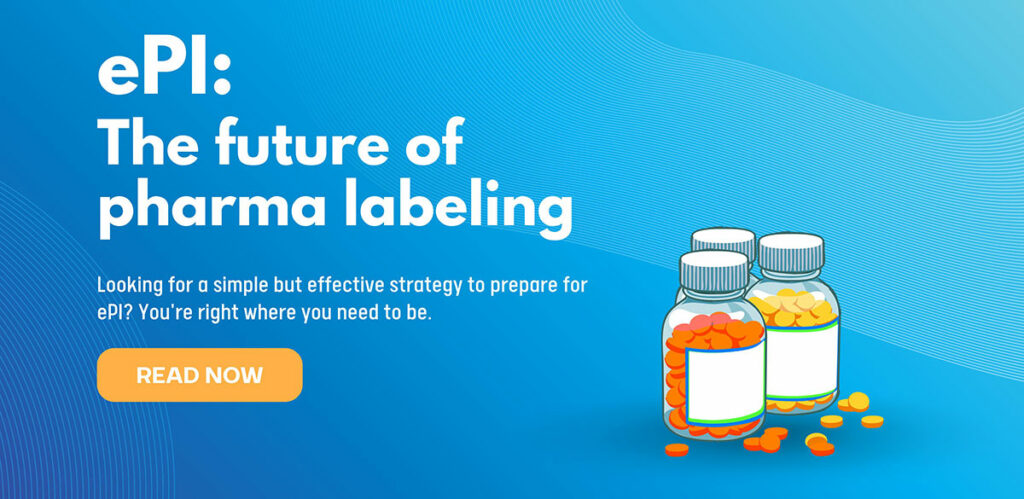
The pharmaceutical industry lags behind other major industries in terms of how critical information is relayed to patients; continued reliance on printed, paper-based instructions to inform patients of when and how to use medications makes little sense in our digital world.
Existing pharmaceutical labels are widely considered to be overly complex and inaccessible across patient groups, especially the elderly and those with lower literacy – each year, an estimated 90 million adults in the United States misunderstand prescription drug labels or have trouble following their directions, leading to health problems and, in extreme cases, death.[1]
To improve patient safety and adherence, industry players are adopting Electronic Product Information (ePI) standards that enable the dissemination of simplified, accurate drug information across patient-accessible electronic channels. As of November 8th, for example, the Heads of Medicines Agencies (HMA), the European Commission (EC) and European Medicines Agency (EMA) published for the first time electronic product information (ePI) for selected human medicines harmonized across the European Union (EU). For patients, this means access to real-time product information. For regulators, it means saving time on the label update and approval process.
What is ePI?
Broadly speaking, ePI is an electronic version of authorized, statutory product information like US Prescribing Information, Summary of Product Characteristics, and Package Leaflet for drugs and other medical devices. ePI is stored as raw data in a file format like JSON and XML rather than as text in traditional document formats like Microsoft Word and Adobe PDF) so it can be maintained and distributed via electronic means including machine-readable QR codes, barcodes, and URLs printed on product cartons. Given its structured file formats like JSON and XML, ePI outputs can also be easily extracted, shared, and ingested to promote data interoperability across health authorities and systems.
While ePI will not likely fully replace paper in the near term while printed informational leaflets remain an important option for older generations and populations without internet access, it will serve to make up-to-date information more accessible to both patients and health care providers.
SIDEBAR|| ePI USE CASES
- E-Labeling. Patient consumption of product information via a QR code or web interface; product information can be easily packaged in a user-friendly, digestible format that includes audio and video options for maximum accessibility and understanding.
- Health Care Professionals: Specialists who check for new side effects in the prescribing system when renewing prescriptions for chronic conditions, approve prescription renewals with messages in personal health records, and come into contact with patients.
- Health Authority Interactions. Direct communication and collaboration between regulators who administer Health Laws and market authorization holders required for the approval of regulatory submissions like product labeling.
- Clinical Trials. Exchange of clinical trial results and research data between pharmaceutical companies and the contract research organizations that administer the trials.
- Exchange of Other Health Information. Provision of integrated healthcare across a wide range of teams, organizations, and contexts like in-patient, ambulatory and acute care.
What are the benefits of ePI?
Access to Real-Time Product Information
Pharmaceutical labels and other paper-based product information are often at risk of being out-of-date, either because new safety guidelines were identified after a batch of products was distributed, or because medications tend to sit untouched in patients’ medicine cabinets for extended periods.
Communicating updated safety guidance can take months or even years, depending on companies’ labeling cycle times and how much stock is already out in the markets. To address this issue, ePI provides immediate access to the most up-to-date, regulator-approved product information.
For example, patients can use a QR code with a direct link to the corresponding ePI in their native language to access the most recent, accurate information regarding their medication, which can mitigate the risk of confusion or misinformation. ePI can also provide automated alerts for major updates to product information, so both patients and healthcare providers can make fully informed decisions as information rapidly evolves around about certain medications.ePI can also mitigate the risks to patient safety when the instructions on paper-based are damaged, misplaced, or discarded.
Patients can access timely information about their medications 24/7 via QR codes, barcodes, and URLs printed on product cartons that can be scanned from mobile phones, tablets, and laptops.
User-Friendly, Searchable Interface
Many patients find it difficult to identify the parts of a label relevant to their circumstances. The small print on the packaging and paper inserts can be difficult to read. The amount of detail and the different languages that pharmaceutical companies are required to provide in each label can make it difficult to find the most important information. This, coupled with unclear dosing directions, can cause patients to make potentially life-threatening mistakes when taking their medications.
User-friendly interfaces powered by ePI can provide patients with immediate access to comprehensive, easy-to-read and zoomable instructions on how to properly administer medications, as well as additional audio and video materials to facilitate accessibility, improve health literacy, and support safe use of the medication. Further, the file format of ePI enables patients to conduct targeted searches for specific medical conditions, treatments, and safety advice.
Promotes Data Interoperability
ePI standards like Pharma Ledger and HL7 FHIR2 are designed to enable the exchange of healthcare-related information, including product information and clinical, healthcare-related administrative, public health, and research data. ePI specifications build on and adapt modern, widely used RESTful API practices to enable the provisioning of integrated healthcare across a wide range of teams and organizations.
This provides healthcare professionals with easy access to more complete patient records, which allows for more informed care and for physicians to share relevant information more easily with specialists, clinics, and hospitals. In the case of labeling, ePI allows pharmaceutical companies to directly communicate and collaborate with Health Authorities and regulators to obtain approval packaging language. This will speed up the amount of time it takes regulators to review, recommend updates, and approve packaging language, ensuring that critical label updates are disseminated to patients faster and more efficiently
Reduces Manual, Administrative Burden and improves environmental sustainability
Implementing effective cost saving initiatives is an important way that pharmaceutical companies can improve their bottom lines and gain competitive advantage. Currently, pharmaceutical companies spend millions of dollars each year on formatting, translating, reviewing, approving, and printing drug labels.
The introduction of ePI will facilitate more effective and faster change management, version control, traceability, and the use of advanced translation tools. This is largely because ePI outputs are generated by leveraging AI-powered component content management systems. Additionally, while ePI will not likely fully replace paper in the near term, it could one day eliminate all costs and environmental impacts associated with printing and paper package labels.
ePI and the Future of Pharmaceutical Labeling
All global labels will soon need to be converted from their current health authority-approved format into the ePI FHIR format. Vulcan, an HL7 accelerator dedicated to connecting clinical research and healthcare, recently published an implementation guide for ePI FHIR. Similarly, the EMA will begin accepting FHIR outputs on a trial basis.
Scaling to meet these requirements will be a cumbersome, expensive, and time-consuming process for pharmaceutical companies and will likely necessitate 1) outsourcing of conversions and/or 2) implementation of an end-to-end labeling solution that includes the capability to generate ePI FHIR outputs and provides additional advanced functionality to optimize end-to-end labeling.
Glemser’s Unique Approach to ePI Generation
ePIs are generated using the following process: 1) ingest existing product information/labels; 2) append ePI tags and other metadata; 3) transform the converted data into an agency-neutral (i.e., XML) file; 4) generate an output. At Glemser, we augment this process by employing artificial intelligence native to our ComplianceAuthor AI end-to-end labeling solution to reduce ePI generation to less than two days and help life sciences regulatory professionals produce submission-ready outputs that meet the requirements of both Pharma Ledger and HL7 FHIR.
Specifically, ComplianceAuthor AI can easily convert unstructured data to structured data from source repositories by employing natural language processing and generative AI. The data is then stored in a proprietary agency-neutral XML format with the appropriate tags, so it is easy to convert to the proper output format via an XML-to-XML transformation. A submission-ready, compliant output is then automatically generated in the appropriate format with verified translations.
Once the output is generated, Glemser experts perform detailed quality checks to resolve deviations to produce a submission-ready, compliant output.
Ready to start preparing for ePI FHIR? Contact Glemser today to get started.
1 Do You Find Prescription Labels Hard to Read? You Are Not Alone | Quality Matters | U.S. Pharmacopeia Blog (usp.org)
2 FHIR (Fast Healthcare Interoperability Resource) is a standard for health care data exchange, published by Health Level Seven International (HL7).


